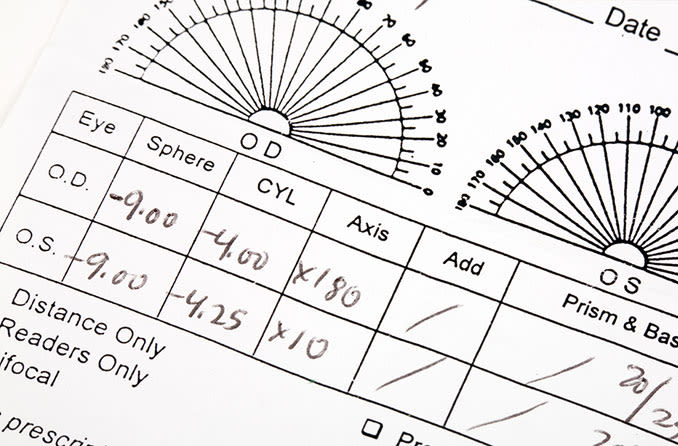How to read your eye prescription

You've just had an eye examination and your optometrist has given you a spectacle prescription.
He or she probably mentioned that you are short sighted, long sighted, or perhaps that you have astigmatism. (If that's not the case, and you still need an eye test, please find an optometrist near you.)
But what do all those numbers on your spectacle prescription mean? And what about all those abbreviated terms, such as OD, OS, SPH and CYL?
This article will help you decipher all parts of your prescription and discuss it knowledgeably with an optometrist when you're buying glasses.
What OD and OS mean
The first step to understanding your spectacle prescription is knowing what "OD" and OS" mean. They are abbreviations for oculus dextrus and oculus sinister, which are Latin terms for right eye and left eye.
Your spectacle prescription also may have a column labeled "OU." This is the abbreviation for the Latin term oculus uterque, which means "both eyes."
Though the use of these abbreviated Latin terms is traditional for prescriptions written for spectacles, contact lenses and eye medicines, most optometrist modernise their prescriptions and use RE (right eye) and LE (left eye) instead of OD and OS.
Other details on your eye prescription
Your spectacle prescription contains other terms and abbreviations as well. These include:
Sphere (SPH). This indicates the amount of lens power, measured in dioptres (D), prescribed to correct shortsightedness or longsightedness. If the number appearing under this heading has a minus sign (–), you are shortsighted, (the clearest focus falls ‘short’ of the light sensitive retina). If the number has a plus sign (+) or no sign, you are long-sighted (the clearest focus falls ‘long’ of the light sensitive retina).
The term "sphere" indicates that the correction for shortsightedness or longsightedness is "spherical," or equal in all directions in the eye (like a soccer ball).
Cylinder (CYL). This indicates the amount of lens power for astigmatism. If nothing appears in this column, either you have no astigmatism, or your astigmatism is so slight that it is not really necessary to correct it with spectacle lenses.
The term "cylinder" indicates that the lens power is not spherical and needs to correct only one direction on the eye. What this means in most cases, is that the ‘cornea’, the clear window on the front of the eye, is not the same shape in all directions, (more like a rugby ball). A cylindrical lens is like a soft drink can. If you look at the top it has a curve that creates a lens power, but turn it on its side and its edges are flat resulting in no power. This means the power can be placed along one direction on the eye.
The number in the cylinder column are usually preceded with a minus sign but occasionally you may see it preceded by a plus sign. Cylinder power always follows the sphere power in a spectacle prescription.

Meridians of the eye are determined by superimposing a protractor scale on the eye's front surface. The 90-degree meridian is the vertical meridian of the eye, and the 180-degree meridian is the horizontal meridian.
Axis. This shows position on the cylindrical lens that contains no power to correct astigmatism. The axis is defined with a number from 1 to 180. The number 90 corresponds to the vertical meridian of the eye, and the number 180 corresponds to the horizontal meridian.
If a spectacle prescription includes cylinder power, it also must include an axis, which follows the cyl power and is preceded by an "x" ,e.g. -1.00 x 90.
The axis of the lens is 90 degrees away from the cylinder power.
Add. This is the added power to assist people to read and can be found in the bottom part of progressive and bifocal lenses to correct presbyopia. The number appearing in this section of the prescription is always a "plus" power, even if it is not preceded by a plus sign. Generally, it will range from +0.75 to +3.00 D and will be the same power for both eyes.
Prism. This is the amount of prismatic power, measured in prism dioptres ("p.d." or “⧍”), prescribed to help with eye alignment problems. Only a small percentage of spectacle prescriptions include prism.
When present, the amount of prism is indicated in metric units (0.5 for example), and the direction of the prism is indicated by noting the position of its "base" or thickest edge. Four abbreviations are used for prism direction: BU = base up; BD = base down; BI = base in (toward the wearer's nose); BO = base out (toward the wearer's ear).
Sphere power, cylinder power and add power always appear in dioptres. They are in decimal form and generally are written in quarter-dioptre (0.25 D) steps. Axis values are whole numbers from 1 to 180 and signify only a location, not a power. When prism dioptres are indicated, typically only one digit appears after the decimal point (e.g., 0.5).
Additional Information. Your optometrist also might write specific lens recommendations on your spectacle prescription — such as anti-reflection coating, photochromic lenses and/or progressive lenses — to give you the most comfortable vision correction possible.
An example of an eye prescription
Confused? Let's use an example to clear things up. (Pun intended.)
Here is a sample spectacle prescription
RE (OD) -2.00 sph Add +2.00 0.5⧍ BD
LE (OS) -1.00 / -0.50 x 180 Add +2.00 0.5⧍ BU
In this case, the optometrist has prescribed -2.00 D sphere for the correction of shortsightedness (myopia) in the right eye (RE, or OD). There is no astigmatism correction for this eye, so no cylinder power or axis is noted. This optometrist has elected to add "sph," to confirm the right eye is being prescribed only spherical power. (Some doctors will add "DS" for "dioptres sphere;" others will leave this area blank.)
The left eye (LE, or OS) is being prescribed -1.00 D sphere for myopia plus -0.50 D cylinder for the correction of astigmatism. The cyl power has its axis at the 180 meridian ( horizontal), meaning the 180 degree meridian of the eye has no added power for astigmatism and the vertical (90 degree) meridian gets the added -0.50 D.
Both eyes are being prescribed an "add power" of +2.00 D for the correction of presbyopia, and this spectacle prescription includes a prismatic correction of 0.5 prism dioptre in each eye. In the right eye, the prism is base down (BD); in the left eye, it's base up (BU).
A glasses prescription is not a contact lens prescription
Spectacle and contact lens prescriptions aren't the same. A spectacle prescription is for the purchase of spectacles only. It does not contain certain information that is crucial to a contact lens prescription and that can be obtained only during a contact lens consultation and fitting.

Spectacle lenses are positioned at a distance from the eyes, while contacts rest directly on the eyes. That distance affects the lens power required for eyes to focus properly.
In addition to the information in a spectacle prescription, a contact lens prescription must specify the base (central) curve of the back surface of the contact lens, the lens diameter, and the specific manufacturer and brand name of the lens.
Also, the power of a spectacle prescription frequently is modified when determining the best contact lens power. One reason is that spectacle lenses are worn some distance (usually about 12 mm) from the surface of the eye, whereas contact lenses rest directly on the eye's cornea.
An accurate contact lens prescription can be written only after a contact lens fitting has been performed and the prescribing optometrist has evaluated your eyes' response to the lenses and to contact lens wear in general.
Your prescription is yours to keep
The Optometry Board of Australia clarifies that an optometrist is obliged to provide you with the written prescription following the eye examination.
“Following patient payment of the optometrist’s fee or assignment of Medicare benefits, an optometrist must supply a prescription to a patient upon request if a prescription has been finalised. The right of the patient to the prescription is provided both by common law and by Medicare regulations that are binding on all participating optometrists. No additional fee should be charged for providing a copy of the prescription at the conclusion of an examination.”
The rule is intended to protect the portability of your spectacle prescription, allowing you to use it to buy glasses from the optometrist of your choice.
Page published on Tuesday, 17 March 2020






